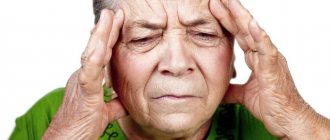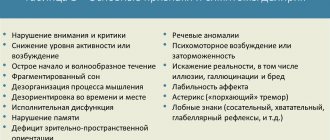04.12.2017
What does the state of “deep stun” mean?
Stunning syndrome is the initial stage of complete loss of consciousness, the so-called precoma. There are several gradations of depression of consciousness: moderate, deep stupor and stupor, after which coma sets in - complete loss of consciousness, when the perception of external stimuli is practically excluded.
How does moderate stun differ from deep stun?
Moderate stunning is accompanied by a slowdown in mental activity and a decrease in the ability to actively pay attention. You can communicate with the patient, but his answers to questions are delayed, sometimes the question needs to be repeated or the victim needs to be patted. The patient quickly gets tired, his facial expressions are poor, the patient reacts to pain, and may lose orientation in the area.
With deep stupor, the patient experiences drowsiness, he rarely makes any movements and his mental activity is difficult. Verbal contact with the victim is severely difficult, answers can only be obtained after persistent requests, they are monosyllabic in nature - “yes”, “no”, while the victim is able to provide his information: full name, age. When communicating with him, you need to repeat the same word over and over again. In this case, the victim is able to follow basic commands: open his eyes, show his tongue, etc. The defensive reaction to pain is preserved, but orientation in place and time is absent.
Disorder of consciousness
There are quantitative and qualitative disorders of consciousness. Quantitative symptoms include stupor, stupor, and coma. Qualitative ones include delirium, oneiroid, amentia, twilight disorders of consciousness, ambulatory automatism, fugue and trance, double orientation. Special states of consciousness include psychosensory disorders associated with a narrowing of consciousness. Exceptional states of consciousness: pathological intoxication, pathological affect, special ethnic changes in consciousness (amok, low, koro, etc.). There are also multiple consciousnesses in multipersonality disorder, and second life syndromes, which are characterized by radical changes in the self without amnesia of the previous self.
Comparative characteristics of syndromes of impaired consciousness
| Syndrome | Orientation | Amnesia after exiting the state | ||
| Personality | Time | Place | ||
| Delirium | + | — | — | — |
| Oneiroid | — | — | — | +- |
| Twilight | +- | +- | +- | +- |
| Amentia | — | — | — | +- |
- no orientation / no amnesia; + orientation is present; +- approximate orientation / partial amnesia
Stunning (raush) is preceded by drowsiness (doubtfulness), in which the patient responds slowly to questions, sometimes with half-closed eyes, he is inhibited and drowsy. Actually, deafness is characterized by all the minimal symptoms of impaired consciousness, that is, passivity of attention, blurred perception, weakened memorization and recollection, impaired comprehension, decreased ability to make judgments and inferences. Euphoria and fussiness are possible.
Patient S., 19 years old, notices that twice during the course of a week he experienced states of fainting, which were expressed in the fact that his vision began to get dark, sounds were removed and turned into ringing, the inside of his stomach seemed to get cold, his body went limp. In these states, he answered questions slowly, turned pale and covered in sweat. After two seconds, the state returned to normal and perception was restored.
It is precisely states of this kind that M.O. Gurevich called it disintegration of consciousness. Sometimes they resemble the processes of physiological falling asleep.
Stupor is a further disturbance of consciousness disorders. Characterized by disorientation, grasping and proboscis movements, muttered speech, and uncoordinated movements. Pain sensitivity, pupillary, conjunctival and corneal reflexes are present.
Coma is a complete loss of consciousness. Characterized by muscle atony, areflexia, mydriasis with absence of pupillary reactions. Quantitative disorders of consciousness are exogenous disorders and are observed in vascular disorders, severe intoxication, endocrine disorders, epilepsy (epileptic coma), after traumatic brain injury and in the terminal stages of dying (vegetative coma). Assessment of the severity of brain damage using the coma scale is given in the Appendix.
Coming out of a coma is often characterized by so-called out-of-body experiences that resemble dream-like (oneiric states).
I clearly saw myself on the operating table and watched as people in white coats were moving faster and faster around me, they were doing something to my body. Suddenly the pain disappeared. Then I moved into a room in which there was nothing, and there was a breath from the ceiling. There was a blinding white light from above, which, like a funnel, sucked me higher and higher. It is an indescribably pleasant state to lose your body. When I returned there was disappointment and pain.
Delirium (delirious syndrome) is characterized by a violation of orientation in place and time while maintaining orientation in one’s own personality, an influx of frightening visual, less often auditory, hallucinations, and fear. Hallucinations are often zooptic (animals, especially often reptiles, devils). The patient's behavior is determined by the content of hallucinatory images. After recovery from delirium, there is no amnesia. Occurs in organic disorders and intoxications and is considered an exogenous syndrome.
Patient K., 68 years old, after interrupting his alcoholic binge, began to see collapsing locks on the wall, people with scary faces surrounded him and tried to strangle him. At the same time I saw a series of flying UFOs. He ran away from home and hid in the forest. During hospitalization, he insisted that he was staying with his friend, who had died several years ago, he named the year and time of year incorrectly, and was confused about dates. There is an expression of horror on his face.
Amentia (amentive syndrome) is characterized by complete disorientation, incoherent speech (thinking), groping movements and partial or complete amnesia after recovery from amentia. When delirium progresses to amentia, one of the first symptoms is muttering and picking movements (delirium delirium). Occurs in organic disorders and intoxications, and also refers to exogenous syndromes.
Patient L., 34 years old. Upon admission to the clinic, he correctly named his passport details, but was disoriented in place and time. I saw people hanging outside the window and felt fear. I didn't sleep for two nights. By the end of the day of admission, he lies within the bed, pulling the blanket over himself with stereotypical movements. Speech is quiet, mumbling, repeating individual syllables, sometimes shouting “I’m coming, I’m leaving.” The gaze does not fixate, looks around, bites its lips.
Twilight disorders are characterized by a narrowing of consciousness with an influx of visual hallucinations, often colored in yellow and red tones (erythropsia) and partial or complete amnesia after emerging from twilight. More common in epilepsy.
Patient D., 30 years old, has a history of epilepsy. For two days I was at the airport with my husband, waiting for my flight, which was constantly delayed. Suddenly disappeared. Then, according to her words, she found herself immediately at home, although she recognized only one room, for some reason immersed in “red darkness” because of special curtains. In fact, she moved 10 kilometers away from the airport, broke a window in a kindergarten and fell asleep on the floor. She could only give an approximate date, although she named the month and year, and believed that “my husband went out somewhere and they had already flown home.”
Oneiroid (oneiric syndrome) is a disorder of consciousness with complete disorientation, an influx of cosmic or apocalyptic visual hallucinations, exit from oneiroid without amnesia. Characteristic of catatonic schizophrenia, sometimes found in cases of intoxication with psychoactive substances and epilepsy. It is considered predominantly an endogenous syndrome.
Patient K., 42 years old. Delivered to the clinic by rescuers. He was discovered in a clearing in a mountain forest, sitting by an extinguished fire. He did not answer questions and followed instructions passively. The state of lethargy and passivity with indifference continued for another week. After recovering from the state, he reported that he had been abducted from the forest by aliens who had been traveling with him “in a beam of light” into the past for about 30 years. I saw how pyramids were built, canals in Mexico, canals on Mars, then dinosaurs. After being discharged, he published an article in an esoteric newspaper about the types of aliens and gave examples of their language, consisting of stretches of the letter “a”.
Ambulatory automatism is characterized by switching off consciousness with automatic actions and amnesia. If such actions are accompanied by excitement, but last up to several seconds (jogging, slamming a door), they talk about a fugue, if for a long time (several days), they talk about a trance. Occurs in epilepsy.
Patient L., 24 years old. Two years ago he suffered a traumatic brain injury. Periodically, headaches with nausea occur. One day he rode his bike to the store and disappeared. Was discovered by police in the city, almost 40 kilometers away, a week later. I couldn’t say my name or pinpoint the date; I didn’t know how I ended up in the city. Neurological examination showed horizontal nystagmus. Confused, trying to remember the events of the past week. Relatives establish that he was passing through neighboring settlements, where he was noticed by acquaintances, but did not react to their responses, “he was looking somewhere ahead.” I lived for several days in an abandoned house, collecting scraps. After the therapy, memory was restored only for current events, but amnesia remained for the period of trance.
Double orientation is characteristic of delusions, for example, delusions of grandeur, when the patient calls himself both a significant person and his name, or with delusions of staging, he claims that although he is in a given place, he still considers it not genuine, staged.
Patient Zh., 30 years old. Political leader of one of the parties. He was brought from a meeting of his party in psychomotor agitation. Oriented correctly in place and time. However, he assures that at the time of the rally, simultaneously with the speeches of the speakers, executions took place behind the stage, and he heard shots. He understands that he is in the department, but believes that all the people have been recruited by opponents. Although he knows the date of hospitalization, he believes that with the help of drugs, those around him are “moved away from the election date by changing calendars.” He calls himself correctly, but believes that at the same time he is “initiated into higher ideas.”
Special states of consciousness include psychosensory disorders in the form of derealization, depersonalization against the background of a narrowing of consciousness.
Exceptional states of consciousness include pathological intoxication and pathological affect. Pathological intoxication is a narrowed state of consciousness, observed when consuming a minimal dose of alcohol, aggression or other unmotivated actions followed by amnesia.
Patient N., 19 years old. Delivered from the pool where he participated in a diving competition. During the swim, he tried to strangle his opponent underwater. When extracted from the water, he behaved inappropriately, rushed at his comrades, tore off his swimming trunks, and screamed inarticulately. The condition became amnesic. When the circumstances were clarified, it turned out that previously the inner surface of the mask had only been wiped dry or washed with water during the swim, but on that day the coach recommended wiping it with alcohol. Previously, N. had never taken strong alcoholic drinks and only tried beer once.
Pathological affect is an inadequate strong reaction to insult, humiliation, loss with a narrowed consciousness, aggression, auto-aggression. Special ethnic changes in consciousness (amok, low, mirriri) also refer to pathological affect. According to the description of ethnographers, the Indian custom of self-immolation of widows after the death of a spouse was often associated precisely with an affective narrowing of consciousness.
Patient S., 35 years old. He was undergoing inpatient treatment for alcohol dependence and was preparing for discharge. I was expecting a visit from my wife and two sons, who were supposed to arrive by car. However, they met with an accident and died. After reporting this event, he turned and ran away, hit a bystander and tore his clothes, causing significant damage to himself.
There is also multiple consciousness in multipersonality disorder, which is characterized by the transition of a personality into another personality with different habits, behavior, name and amnesia of the previous personality.
How is stun different from stupor?
Both disorders are characterized by severe lethargy, immobility, and difficulty in contact. However, stupor, as a rule, develops against the background of a somatic illness, trauma, infection, etc., and stupor occurs during the course of mental illness, primarily schizophrenia. When stupor occurs, the patient experiences delusions and hallucinations, while stupor is characterized by complete indifference and absence of internal experiences.
Published at Mon, 04 Dec 2021 09:32:20 +0000
- 5
- 4
- 3
- 2
- 1
(0 votes, average: 5 out of 5)









